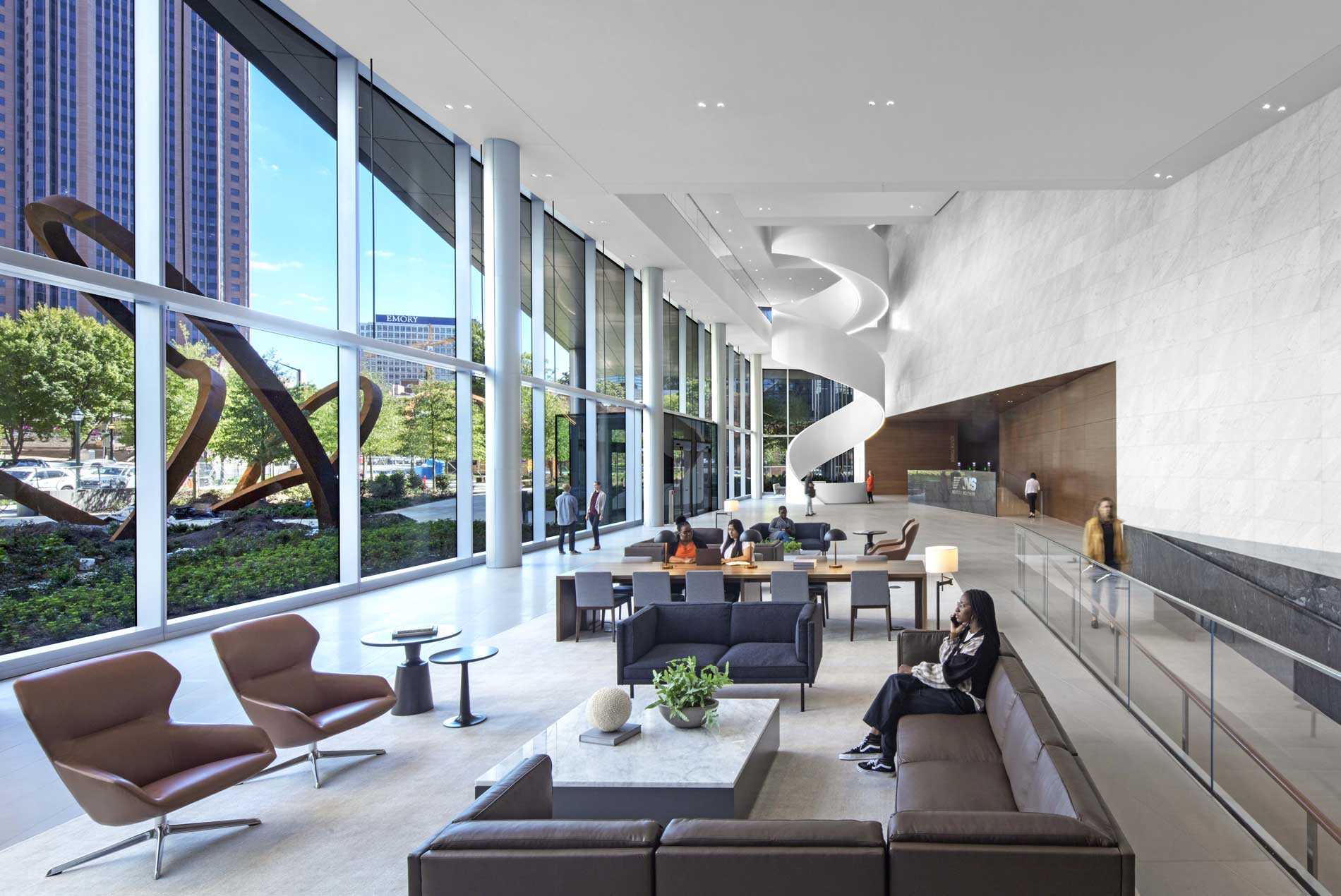The traditional model for designing meeting rooms is obsolete. These spaces are often sterile, impersonal and ill-suited for the needs of today’s diverse workforce. HOK's Gather team—Olivia Danielson-Veed, Kristina Kamenar, Caleb Salomons, Kay Sargent, Caitlin Turner and Ilma Wasty—describe how to transform gathering spaces into high-functioning, purpose-driven collaboration spaces.
Imagine stepping into a traditional meeting room. You encounter the biggest rectangular table that can fit into the space, along with as many chairs as possible. There is a small TV at one end of the room, limited space to stand or maneuver, and bland, painted wall surfaces. The room is silent, except for the clacking of laptop keyboards as people attempt to multitask. You feel bored, short on time and disconnected from your colleagues across the table.
Such rooms, relics of the past, no longer meet the varied needs and work styles of the 2023 workforce.
Gathering spaces are more than just venues for meetings. They act as birthplaces for relationships, ideas and solutions to complex problems. Designers must grasp the true intent of gatherings, the nature of the interactions and the experiences we’re striving to create. This understanding should guide the design process from the outset.
Whether their employees are in the office or working remotely, organizations must empower them to collaborate more effectively. To do this, we’re reimagining the design of gathering spaces. These spaces must be adaptable, purpose-driven and tech-enabled. They should cater to different modes of collaboration, communication and learning. Finally, they should consider the hybrid work experience for everyone, regardless of their location.
Why We Meet
Even before the COVID-19 pandemic, HOK’s WorkPlace group identified the need for more effective gathering spaces. We noted that David Pearl’s book, “Will There Be Donuts?”, described seven distinct types of meetings:
- Problem solving
- Decisions
- Discussions
- Information sharing
- Selling
- Innovation
- Social
We recognized that the spaces for these seven types of meetings should be unique. Over a two-year period, as the pandemic unfolded and workplaces fundamentally changed, our team translated Pearl’s concept into spatial archetypes. We categorized the seven meeting types into three primary reasons for workplace gatherings:
- Day-to-day collaboration
- Meet with purpose
- Build community
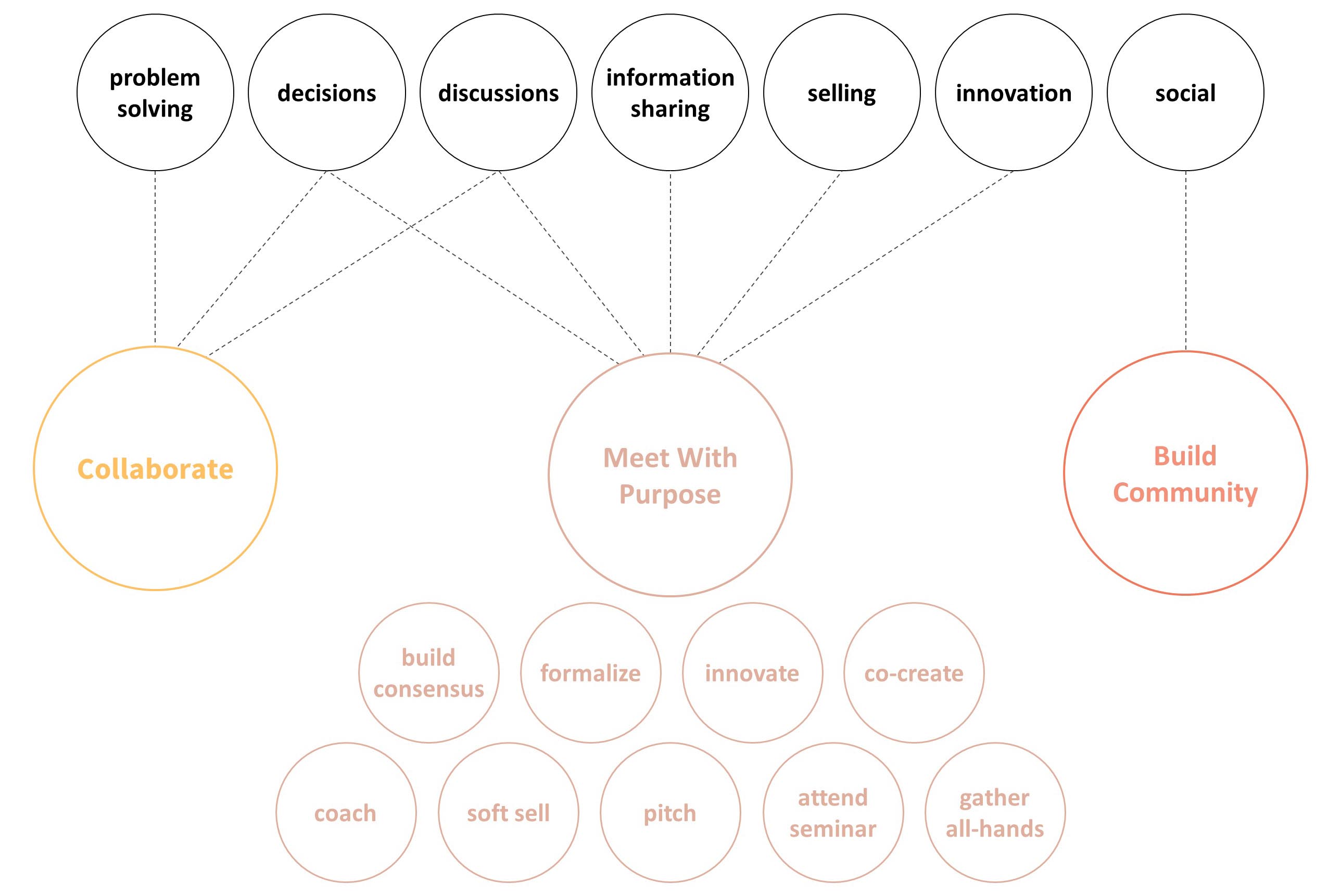
Day-to-day collaboration covers ad-hoc and impromptu interactions. Spaces for this purpose should encourage productive exchanges between coworkers with minimal effort, catering to problem-solving, decision-making and discussions.
When a specific outcome is sought, people meet with purpose. These meetings typically serve one of the following nine purposes:
- Gaining consensus
- Formalizing a decision
- Co-creating
- Innovating
- Soft selling
- Pitching
- Coaching
- Attending a seminar
- Gathering all hands
Designing for these purposes requires a thoughtful assembly of space attributes, including layout, technology, tools and posture, to facilitate the desired result.
The most effective social spaces look, feel and function differently than the rest of the office. Social gathering spaces should be envisioned and crafted through a build community lens to enhance social capital. By shifting the design thought process for these spaces, we can make social gathering spaces more engaging, meaningful and effective.
This article explores the first of these three reasons: day-to-day collaboration. Future articles in this series will examine the remaining two reasons: meeting with purpose and building community.
Day-to-Day Collaboration: Mastering the Fundamentals
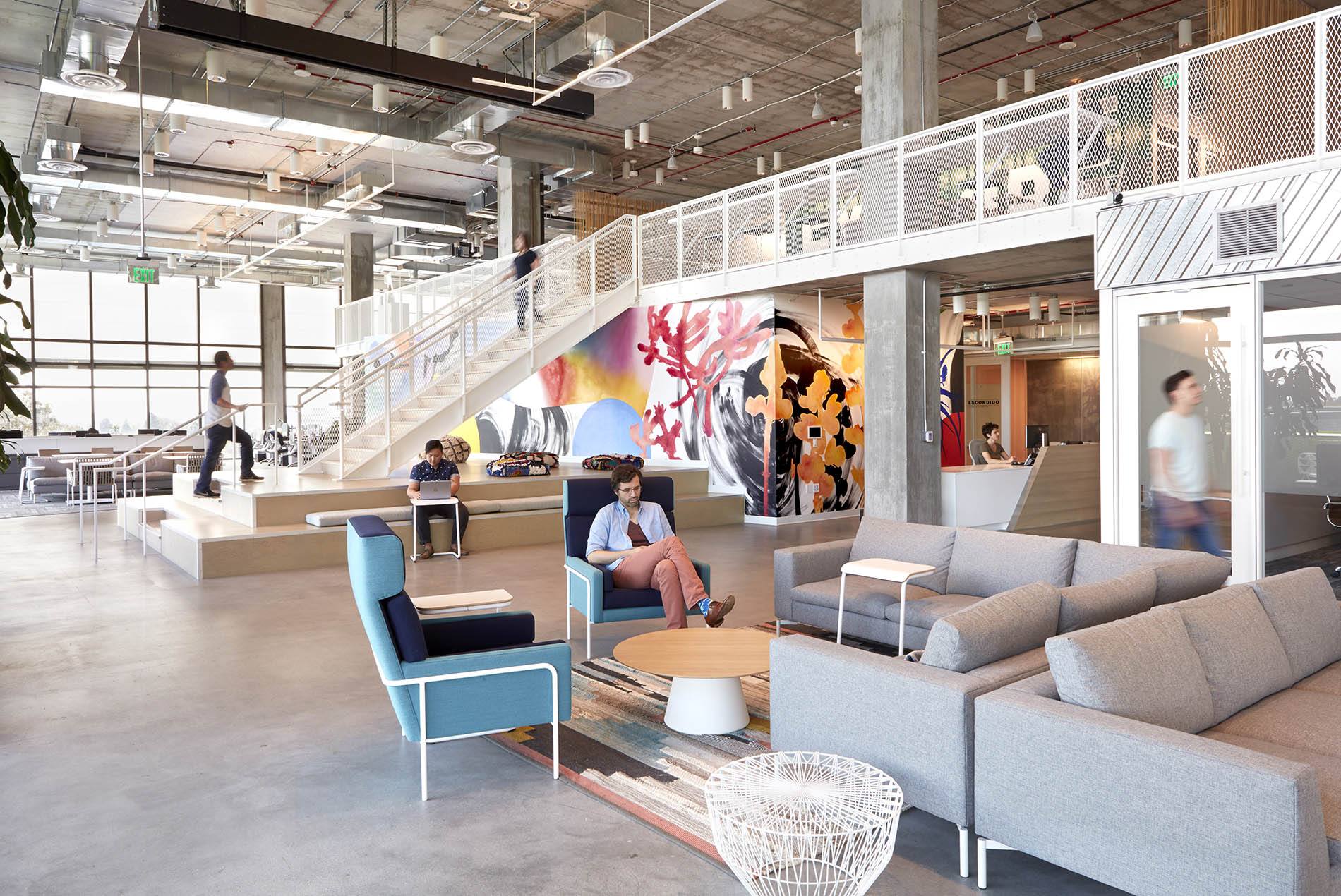
Collaboration is essential for success in the contemporary work ecosystem, making its facilitation non-negotiable in workplace design. Solving for it in a post-COVID world means providing settings that encourage serendipitous in-person interactions and productive virtual connections. Collaboration solutions should include a diverse range of spaces and be future-ready.
HOK’s team has reinvented the way we engage clients when it comes to gathering spaces. Our planning approach helps clients identify the optimal size, shape and level of privacy for collaboration spaces.
The size of spaces is crucial. It’s vital to provide sufficient circulation space around furniture to facilitate collaboration while addressing diversity, equity, inclusion and accessibility.
The shape and height of tables can greatly influence a space’s functionality, utilization and even who virtual attendees can see and hear. For instance, square, oval or triangular tables can each add a different dynamic.
Acoustics is another vital factor. Given the widespread use of videoconferencing in today’s work culture, designers must limit sound transfer while balancing this against ease of access, as collaboration spaces must be conveniently located and visible.
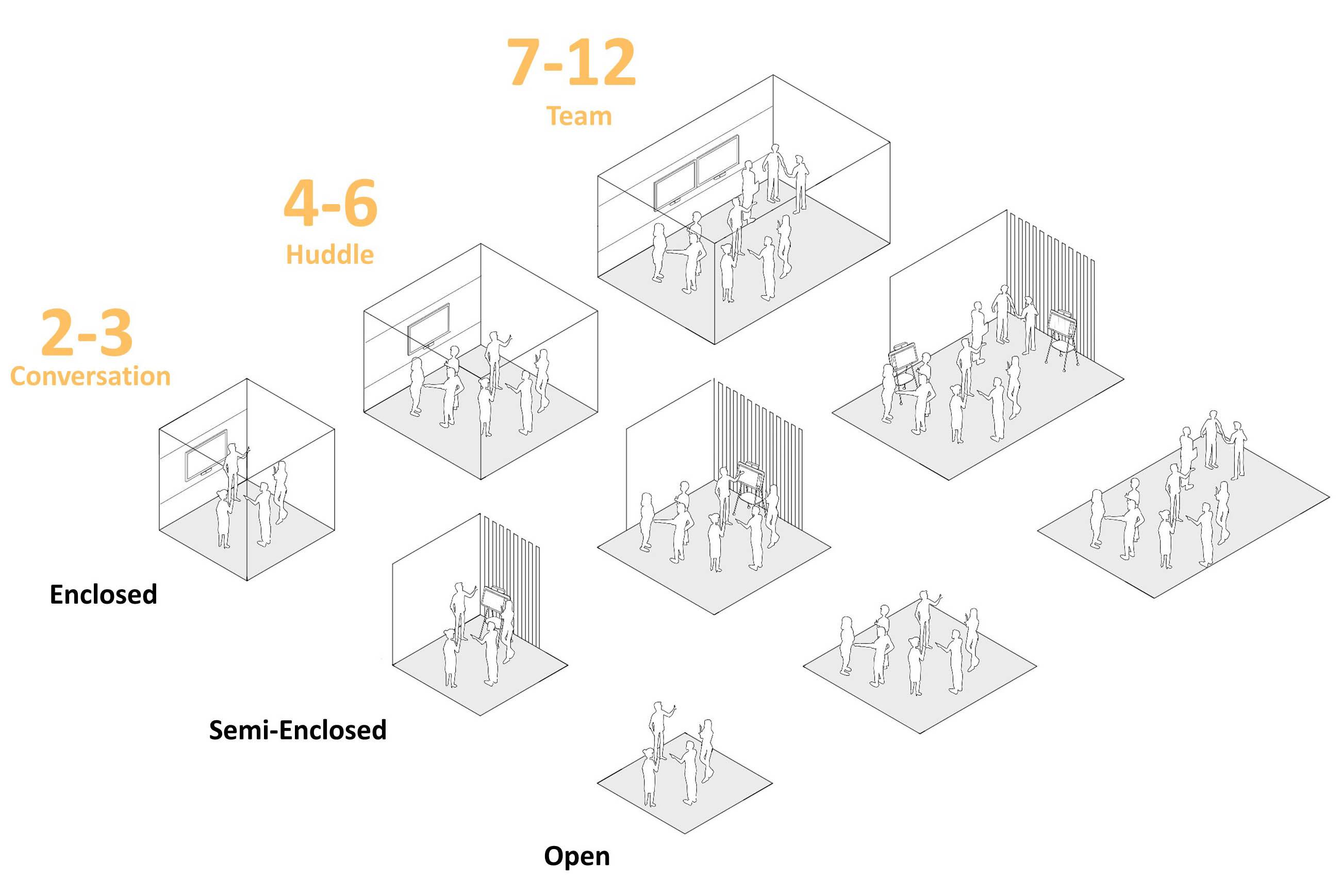
Beyond location, shape and privacy, we delve deeper into an organization or team’ unique work behavior factors. These include the level of enclosure, meeting duration, formality of the engagement, posture and meeting structure.
With 70% of companies adopting hybrid work models, the push for equitable experiences requires a new view of technology integration. We assess the digital and analog tools organizations need to boost interaction and engagement, such as power, configurable setups, monitors and writable walls.
Through our process, we create a set of complementary components that work together to enhance collaboration. The outcomes are specific, not generic, and backed by behavioral science.
The Art and Science of Size and Configuration
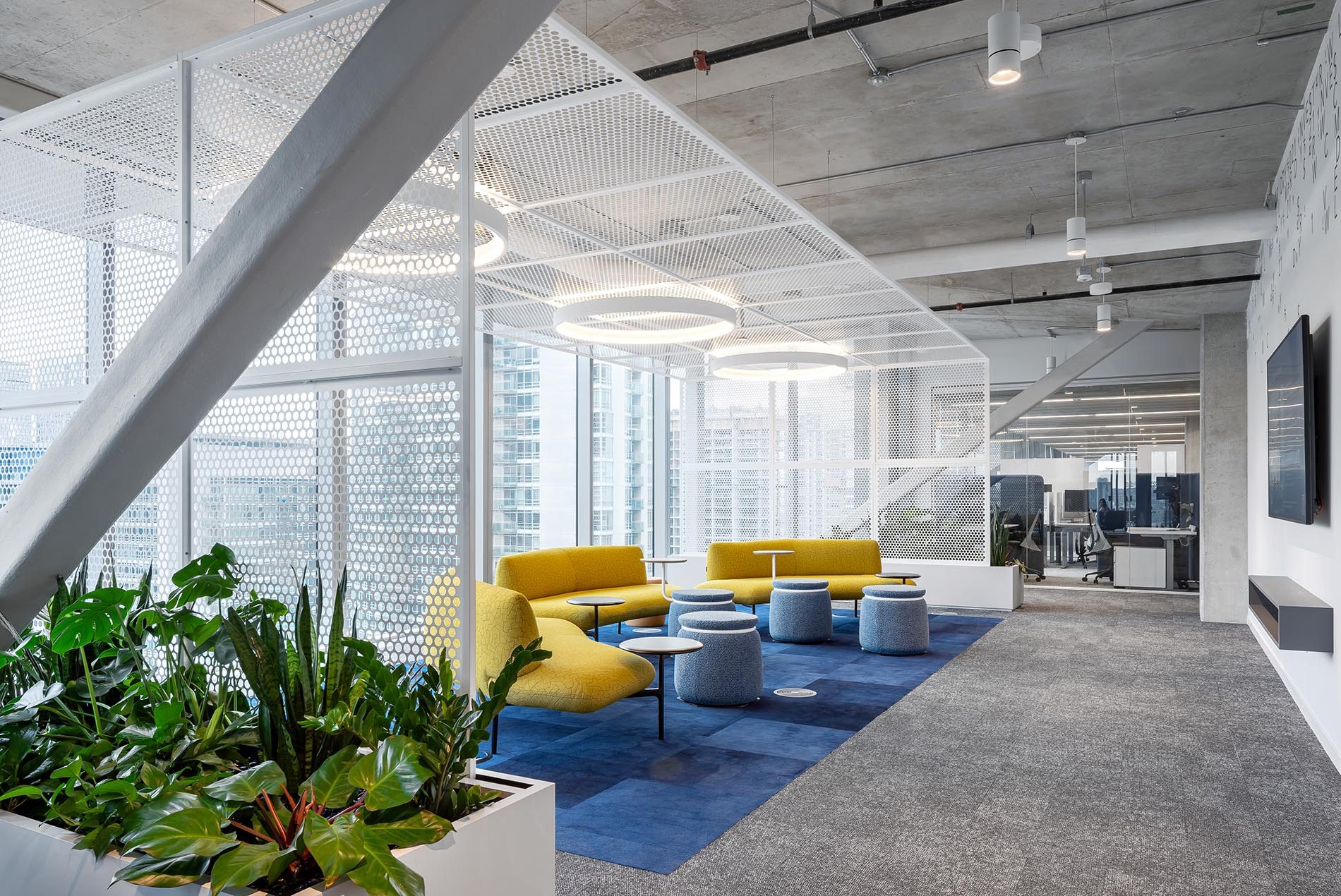
Determining the size and configuration of gathering spaces is a nuanced process. It begins with standardizing size and nomenclature, using terms such as “conversation,” “huddle” and “team” that hint at both the size and function of a space.
For intimate discussions and focused collaboration among two to three people, conversation spaces are ideal. These spaces should be outfitted with analog tools to facilitate shared work and digital tools to foster connection.
Huddle spaces, accommodating four to six people, are ideal for sharing perspectives and strategizing. These spaces should include analog tools for brainstorming and planning, complemented by digital tools allowing for the inclusion of remote participants.
Team spaces, hosting seven to 12 people, are geared toward information sharing and inclusivity. They should be furnished with analog tools that facilitate goal setting and learning, and digital tools enabling content sharing.
Spaces intended for more than 12 people typically fall into the category of meet with purpose spaces. These are designed for larger group meetings and require careful planning to ensure effective collaboration among more participants.
Prioritizing DEI&A in Design
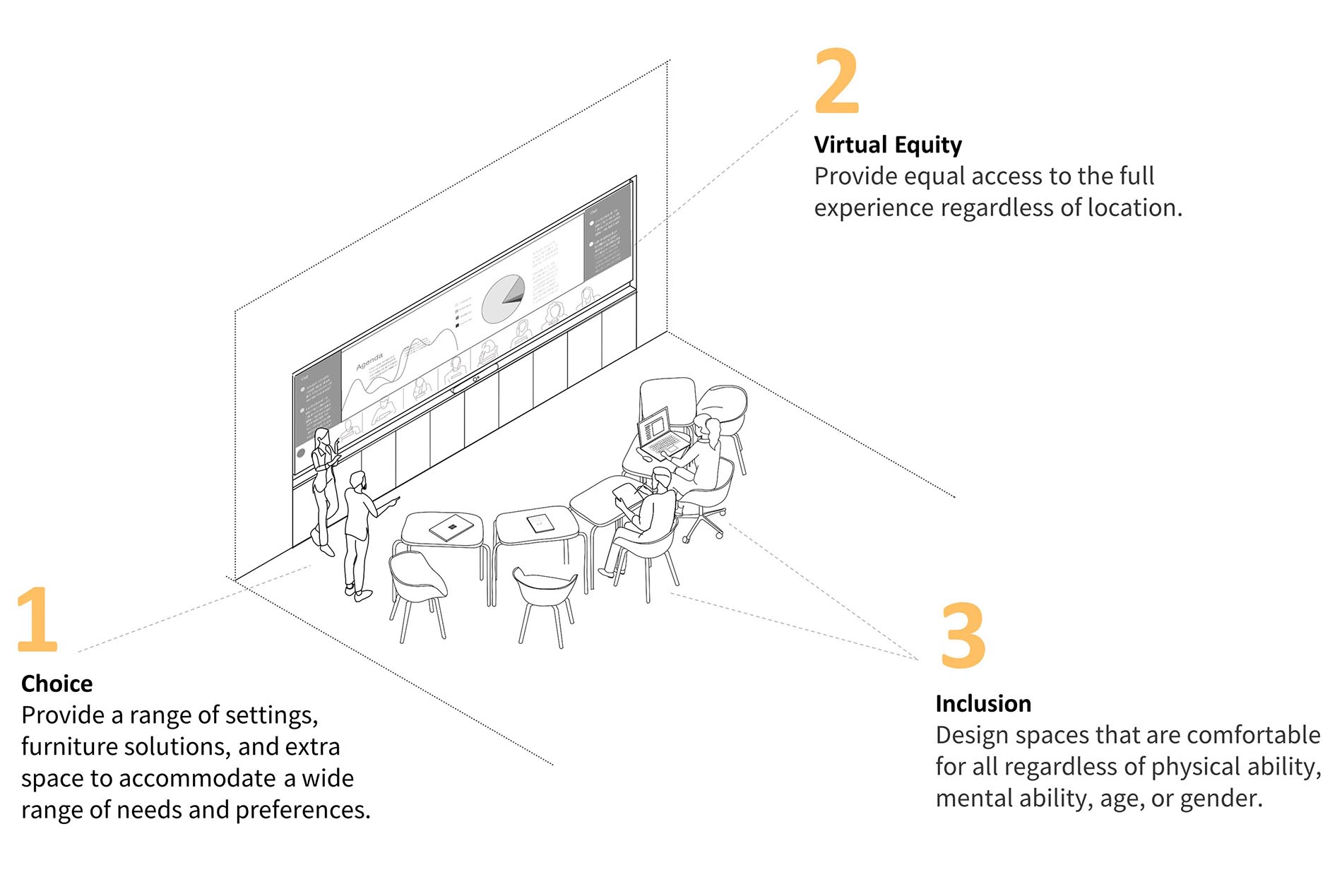
In today’s diverse, multigenerational and neurodivergent workforce, addressing diversity, equity, inclusion and accessibility (DEI&A) in the design of gathering spaces is critical.
Designers must accommodate various needs and preferences by offering choice, flexibility and a range of settings, furniture solutions and tools that cater to individual needs. Spaces should encourage movement and allow people to step away, stand and move around. Non-adjustable or movable furniture may be preferable for its adaptability, and diverse seating options can be highly beneficial. For example, allowing one person to stand during a lengthy meeting while another chooses to slightly rock back and forth while sitting away from the table caters to individual needs.
In the era of hybrid work, virtual equity is equally important. Ensuring that virtual attendees have equal access to the meeting experience and tools, such as two-way digital whiteboards, is essential. The space’s design, including table shapes and configurations, should promote equity. Neutral finishes will ensure that video conferencing cameras capture skin and hair tones accurately. Virtual attendees should be represented at full size and eye level whenever possible, enhancing the sense of inclusion and equity.
The design should be inclusive of all, ensuring equal access regardless of physical or mental abilities. This includes designing spaces that suit both hypo-and hyper-sensitive individuals. For both functional and inclusion reasons, noise control is also important.
Incorporating Digital Technology
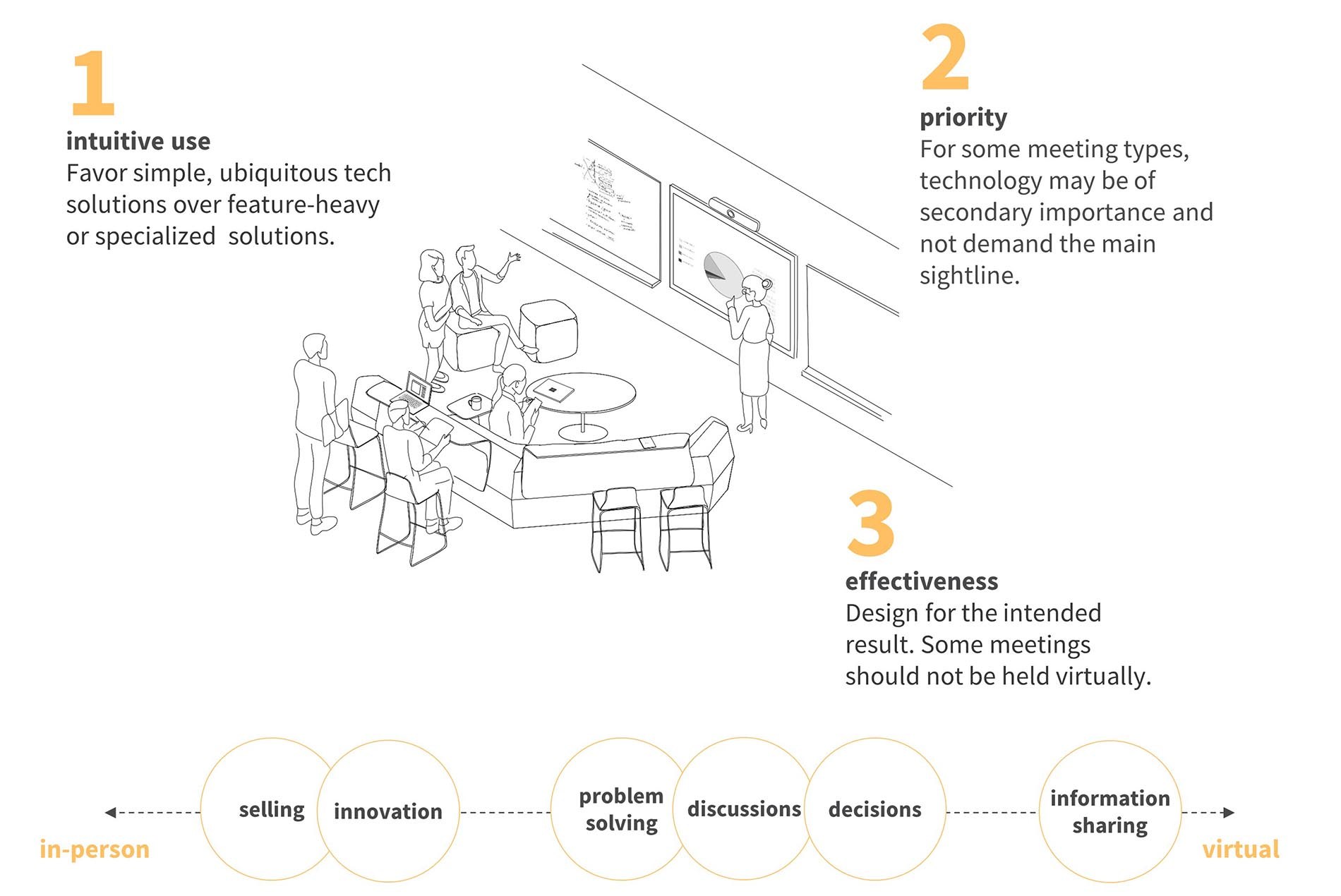
User-friendly technology is critical. In fact, opting for fewer spaces equipped with high-quality technology is preferable to having more spaces with subpar tech. The focus should be on simple, widely available solutions over specialized, proprietary products. Doing this allows for rapid content sharing that enhances collaboration. Evaluating the digital readiness of the users to ensure the tech solutions are intuitive and appropriate for their intended solutions is a crucial element in making sure spaces are usable and high functioning for all.
The priority of the technology within the space is another aspect to consider. Collaboration spaces often have multiple sources of information, including digital content, a presenter, colleague discussions and a writable surface. It’s crucial to determine whether the technology plays a primary or secondary role and to design the space accordingly.
Not all types of meetings are equally effective when conducted virtually. Some, such as training sessions, work well when virtual. With an unlimited audience size, equitable access to content and live commenting tools, technology can offer a potentially superior experience for attendees. Other types of meetings, however, like innovation workshops, need physical engagement. Some meetings simply cannot be virtual without compromising the experience or results. Virtual attendance, comparable to the difference between a mailed letter and a phone call, is best used when it strengthens human connections, provides otherwise limited access or enables co-creation.
Balancing Quantity and Variety
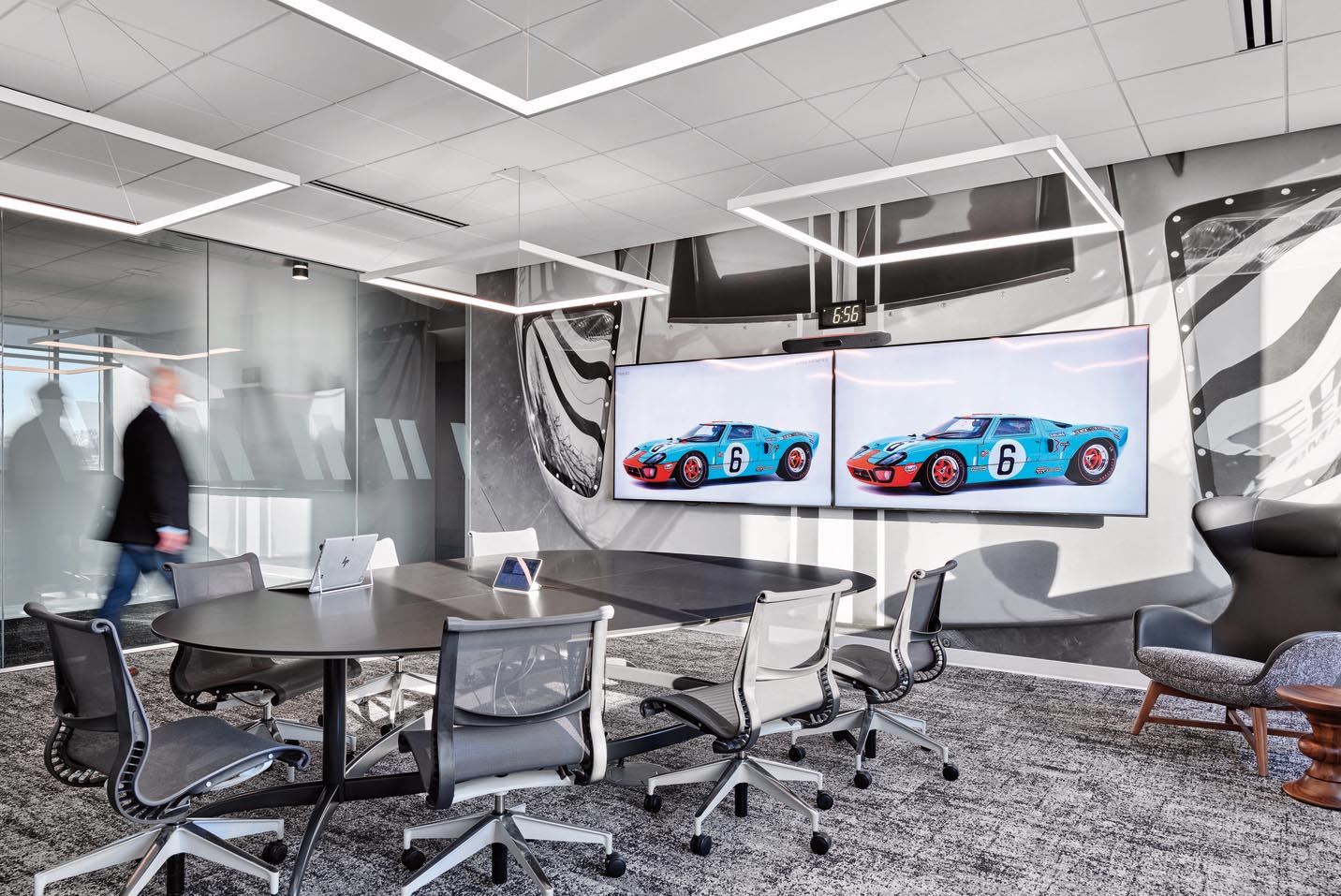
Determining the ideal number and blend of gathering spaces is more art than science, requiring explorative programming. This approach marries traditional data collection methods—surveys, observations, badge data and sensors—with more exploratory techniques such as industry benchmarking, case studies and pilot projects. In this exploration, we look at three pivotal factors: work modalities, demographic details and the organization’s hybrid work strategy.
Work modalities refers to how work is conducted, which can differ quite a bit from team to team. These unique work behaviors shape the ideal mix of spaces. We also don’t want to overlook the importance of chance collisions—spontaneous interactions that often occur in high-traffic areas and foster unexpected collaboration and idea exchange.
Demographic factors, including cultural preferences, average age and geographic region, play a big role in shaping the use of these spaces. By benchmarking against industry or sector standards, we can glean valuable insights into macrotrends, enabling organizations to align their spaces with industry norms and expectations.
An organization’s hybrid work strategy also influences the design and number of gathering spaces. Strategies that promote desk sharing and depend on informal workpoints will require a different blend of spaces. In most cases, hybrid strategies lead to a surge in demand for more spacious meeting rooms to accommodate in-person attendees and remote participants.
Our Discovery Tool
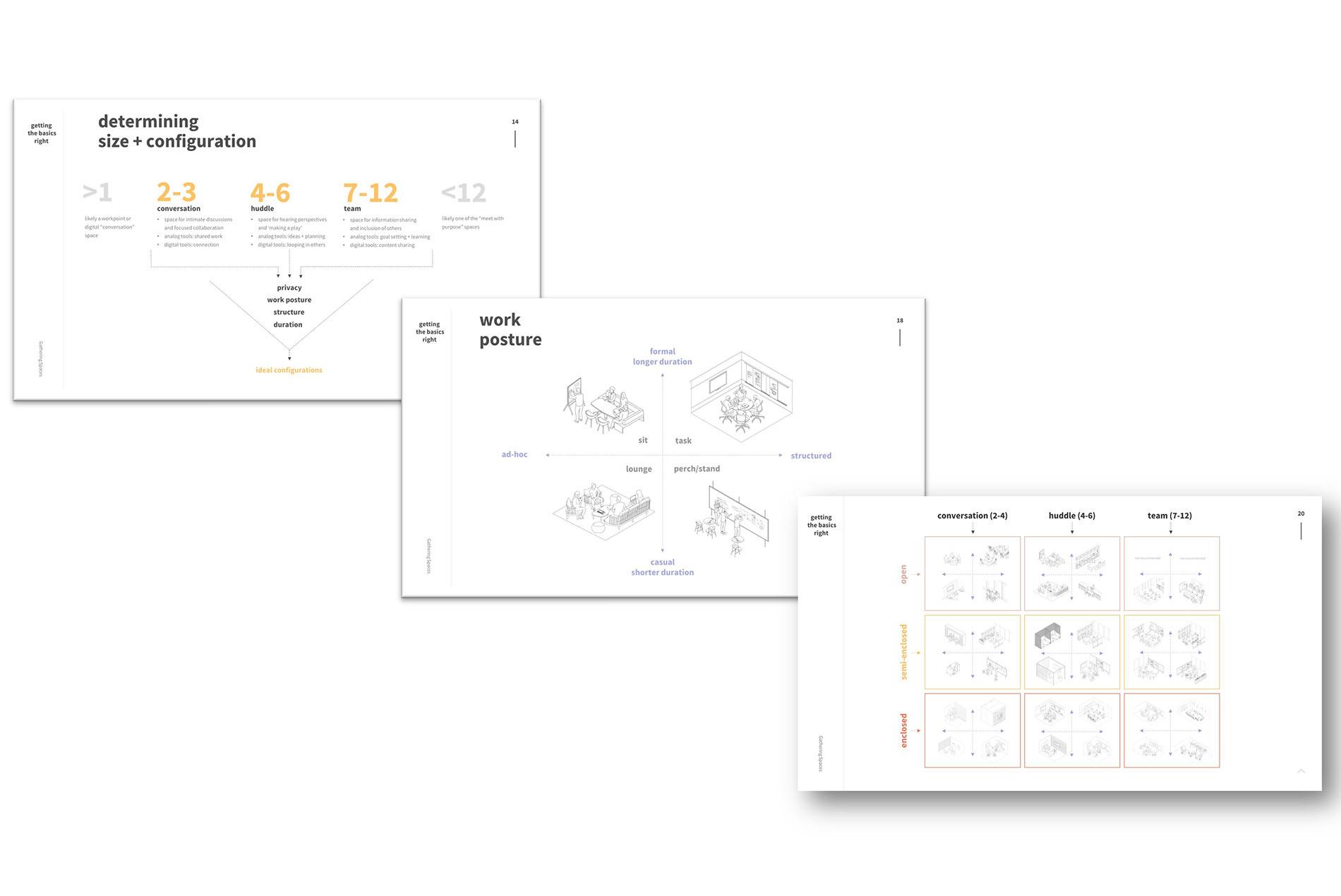
Now is the time to move beyond the questions, “How many meeting rooms do you need and how many people will be in each?” We must start designing spaces that are meaningful and fit for purpose. By revisiting the basics and considering work behavior science, work modalities, demographics and hybrid strategies, we can carve out a future where innovation is the natural outcome of the daily interaction of diverse minds.
Our WorkPlace team uses a discovery process to match work behavior with appropriate settings during the initial programming phase. We guide clients through an exercise exploring various collaboration settings—specifically, the nine primary types and their 36 variations. The tool plots size against factors including level of enclosure, desire for privacy and requirement for confidentiality.
The result is a comprehensive map of potential collaboration spaces. This systematic approach ensures that the final design meets an organization’s functional needs while creating an environment conducive to collaboration and creative exchange.
Let’s Connect
HOK leads the strategic planning, design and implementation of work experiences worldwide.
For more information about how we approach the design of effective gathering spaces or to arrange a workshop for a custom assessment of your needs, please connect with our Gather team:
Olivia Danielson-Veed, Sr. Project Interior Designer, Chicago, olivia.danielson-veed@hok.com
Kristina Kamenar, Director of Design, Interiors, Toronto, kristina.kamenar@hok.com
Caleb Salomons, Sr. Project Interior Designer, Calgary, caleb.salomons@hok.com
Kay Sargent, Director of Workplace, Washington, D.C., kay.sargent@hok.com
Caitlin Turner, Director of Interiors, Toronto, caitlin.turner@hok.com
Ilma Wasty, Sr. Designer, Toronto, ilma.wasty@hok.com
